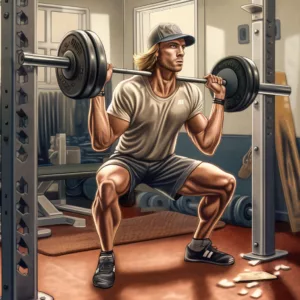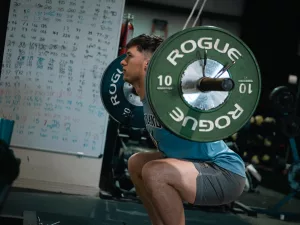 So does squatting increase pitching velocity? What do you think?
So does squatting increase pitching velocity? What do you think?
In baseball, the ability to throw with high pitching velocity is extremely important for a pitcher's overall performance. Coaches and players alike are always looking for ways to improve their throwing speed. The potential impact of squatting exercises on throwing velocity is a question that commonly comes up during these discussions. In the parts that follow, we will investigate the relationship between squatting and pitching speed in-depth, digging into the potential benefits and sharing perspectives from industry professionals.
Pitching velocity is an important aspect of a pitcher's on-field performance. It has an impact on the effectiveness of their pitches and can have a substantial impact on game outcomes. As a result, baseball players are always enticed by the potential of enhancing their pitching speed. Among the different training methods accessible, the subject of whether squatting exercises might help increase pitching velocity is frequently raised. This topic will be thoroughly explored throughout this essay, with an emphasis on the possible benefits of introducing squats into a pitcher's training regimen. To provide a thorough understanding, we will draw on the experience of industry experts and illuminate their perspectives on the relationship between squatting and pitching velocity.
Does Squatting Increase Pitching Velocity?
 The association between squatting exercises and throwing speed has received a lot of research in the attempt to improve pitching velocity. However, a case study named "The Relationship Among Throwing Velocity, One-Repetition Maximum Bench Press and Squat, and Body Composition in College Baseball Pitchers" conducted by Aloi et al. (2019) throws light on the matter with empirical evidence.
The association between squatting exercises and throwing speed has received a lot of research in the attempt to improve pitching velocity. However, a case study named "The Relationship Among Throwing Velocity, One-Repetition Maximum Bench Press and Squat, and Body Composition in College Baseball Pitchers" conducted by Aloi et al. (2019) throws light on the matter with empirical evidence.
The study examined the relationship between the one-repetition maximum (1-RM) squat and bench press tests, throwing velocity, and body mass index (BMI) in collegiate baseball pitchers. Thirteen pitchers from a Division II National Collegiate Athletic Association baseball club volunteered to take part in the study. Each subject's height, weight, and BMI were measured at the start.
The subjects conducted 1-RM tests for both the squat and bench press exercises during the testing period. The researchers also measured the speed of ten maximal effort pitches thrown from a pitcher's mound after a two-day gap to estimate pitching velocity.
The study's findings provided some fascinating insights. The 1-RM readings for the bench press and squat workouts had no significant association with maximal throwing velocity. The correlation coefficients for the bench press and squat were 0.01 and -0.01, respectively. However, with a correlation coefficient of -0.648, a negative association was found between BMI and maximal throwing velocity. This suggests that BMI has the ability to predict throwing velocity in college baseball pitchers.
These data imply that, while squatting exercises alone may not have a direct affect on pitching velocity, other factors such as body composition, as measured by BMI, do. It underlines the significance of taking into account many aspects, such as strength measurements and body composition, while analyzing and improving pitching velocity.
It's worth noting that this case study sheds light on the connection between strength training, body composition, and pitching velocity. Individual variations and additional research, however, are required to provide a thorough understanding of the impact of squatting on pitching velocity.
S. Aloi, M. Ryan, P. Reneau, and J. Matzenbacher dos Santos (2019). In college baseball pitchers, the association between throwing velocity, one-repetition maximum bench press and squat, and body composition was studied. 2019(1), 64-71 in Revista Portuguesa de Ciências do Desporto.
Pitchers' Benefits of Squatting: Insights from the 3X Pitching Velocity Program
 The 3X Pitching Velocity Program, created by renowned pitching coach Brent Pourciau, is a comprehensive training method for increasing pitching velocity. This program focuses on the importance of lower body strength and power, emphasizing the benefits of squatting exercises in improving pitching performance. It answer the question does squatting increase pitching velocity and much more!
The 3X Pitching Velocity Program, created by renowned pitching coach Brent Pourciau, is a comprehensive training method for increasing pitching velocity. This program focuses on the importance of lower body strength and power, emphasizing the benefits of squatting exercises in improving pitching performance. It answer the question does squatting increase pitching velocity and much more!
Let's look at how squatting, as used in the 3X Pitching Velocity Program, can help pitchers enhance their velocity.
- Increased Lower Body Strength: Squatting exercises, such as barbell squats and variations such as front squats or back squats, are essential components of the 3X Pitching Velocity Program. These exercises work the major lower-body muscles, such as the quadriceps, hamstrings, and glutes. Pitchers can improve their lower body strength by including squats into their training routine, giving a stable basis for generating explosive force during the pitching motion.
- Enhanced Force transmission: The 3X Pitching Velocity Program understands the importance of force transmission from the lower to upper body in maximizing pitching velocity. Pitchers can improve their ability to create and transfer power efficiently along the kinetic chain by squatting. Squats boost the transmission of energy from the legs to the arm by strengthening the muscles involved in the pitching motion, particularly those active during the drive phase, allowing pitchers to unleash higher velocity throws.
- Improved Stability and Balance: Maintaining good pitching mechanics and decreasing the risk of injury requires proper stability and balance. Squatting workouts demand core stability and control, which aids with pitching motion balance. Squats are used in the 3X Pitching Velocity Program to assist pitchers build the essential stability and balance, resulting in more consistent and controlled actions on the mound.
- Injury prevention and endurance: Strong lower body muscles are essential for supporting joints and maintaining general stability. Pitchers can strengthen the muscles around their knees and hips by including squats into their training, offering additional protection and lowering the risk of common pitching-related ailments. Squatting exercises are an important aspect of the 3X Pitching Velocity Program's training technique because it understands the need of injury prevention and durability.
It is critical to remember that the benefits of squatting exercises, as stated in the 3X Pitching Velocity Program, are most effective when combined with a thorough training plan. To optimize throwing velocity, the program incorporates numerous components such as good mechanics, arm speed drills, conditioning, and strength training. Squatting workouts are a core component that contributes to the overall development of pitchers who want to improve their velocity.
The 3X Pitching Velocity Program's concepts emphasize the importance of squatting exercises in improving pitchers' lower body strength, force transfer, stability, and injury prevention. Pitchers can unlock their maximum potential and attain higher pitching velocity by including these workouts into their training routine.
Brent Pourciau created the 3X Pitching Velocity Program as a customized training program. When executing the program's ideas and exercises, it is recommended that you get suitable direction and instruction from competent coaches or trainers.
Squatting and Pitching Velocity Frequently Asked Questions (FAQs)
As the association between squatting exercises and pitching velocity piques baseball fans' interest, it is critical to address common queries about the subject. Here are some often asked questions and instructive answers concerning squatting and its effect on pitching velocity:
Q1: What role does squats play in increasing pitching velocity?
A1: When paired with a thorough training program, squatting exercises can help improve throwing velocity by increasing lower body strength. Squats target critical muscles in the pitching motion, allowing pitchers to produce more force from the legs and efficiently transfer it to the upper body. Increased pitching velocity results from enhanced power transmission.
Q2: Can squatting workouts alone improve pitching velocity significantly?
A2: While squatting workouts are beneficial for strengthening lower body strength, improving pitching velocity requires a comprehensive strategy. Squatting may not be enough to obtain large velocity increases. It should be paired with other areas of pitching training that are equally important, including as mechanics, arm speed drills, conditioning, and general strength development.
Q3: How often should pitchers include squats in their training routine?
A3: The frequency with which squatting exercises are performed in a pitcher's training routine varies depending on individual circumstances and training plans. Squats, on the other hand, are generally recommended to be performed 2-3 times a week. Allowing appropriate time for rest and adaptation while keeping consistency in training is critical.
Q4: Are there other workouts other than squats that help improve pitching velocity?
A4: Yes, there are exercises that can be used in addition to squatting to improve pitching velocity. Exercises such as all the clean variations, lunges, deadlifts, and step-ups target similar lower-body muscles and can give training stimulus variation. It is critical to select workouts that meet individual needs and goals while focusing on lower-body strength.
Q5: Can squatting workouts aid pitchers of all ages?
A5: Squatting workouts can potentially assist pitchers of all ages. Individual characteristics such as physical maturity, training experience, and special needs must, however, be taken into account. Younger pitchers should focus on mastering proper squatting technique before gradually increasing intensity and load under expert supervision.
Q6: Are there any hazards involved with pitcher squatting exercises?
A6: Squatting, like any workout, presents some risk if done incorrectly or with too much weight. Prioritize appropriate technique, gradually increase intensity, and seek advice from certified coaches or trainers. Prioritizing safety and excellent technique lowers the chance of injury while increasing the benefits of squatting workouts.
It is advisable, as with any training-related inquiry, to consult with competent coaches, trainers, or sports specialists to receive specific assistance geared to individual needs and goals. The information provided here is intended to be a broad guide to answering common queries about squatting and its effect on pitching velocity.
Unleash Your Full Potential at 3X Velocity Camp!
 Many baseball pitchers want to know does squatting increase pitching velocity. Squatting exercises have developed as a focus of interest in this endeavor. While the direct influence of squatting on pitching velocity varies, it is obvious that including squatting into a comprehensive training program can be beneficial to pitchers.
Many baseball pitchers want to know does squatting increase pitching velocity. Squatting exercises have developed as a focus of interest in this endeavor. While the direct influence of squatting on pitching velocity varies, it is obvious that including squatting into a comprehensive training program can be beneficial to pitchers.
We investigated the relationship between squatting and pitching velocity in this paper, diving into the possible benefits of strengthening the lower body and maximizing force transmission. We also looked at expert advice, such as the concepts of the well-known 3X Pitching Velocity Program.
We recommend that you join the 3X Velocity Camp if you want to improve your pitching velocity. This curriculum, created by pitching coach Brent Pourciau, offers a thorough and scientifically supported method to improving your pitching performance. The 3X Velocity Camp offers significant training approaches that can accelerate your pitching velocity to new heights, with a focus on lower body strength, force transfer, and overall growth.
Don't pass up this chance to show your actual potential on the mound. Join the 3X Velocity Camp and benefit from a planned and specific training program designed to improve your pitching velocity. Learn more and reserve your seat at https://www.topvelocity.net/3x-camp today!
Remember that reaching your pitching goals necessitates commitment, adequate training, and coaching from qualified coaches. Whether you attend the 3X Velocity Camp or other training programs, you should always prioritize your development, maintain consistency, and consult professionals who can provide specialized counsel targeted to your specific needs.
Invest in your pitching future to reach your maximum potential. The path to greater pitching velocity begins right now!




